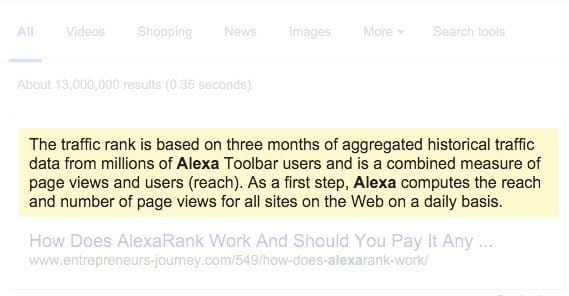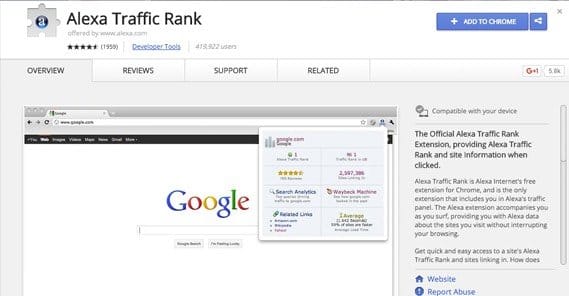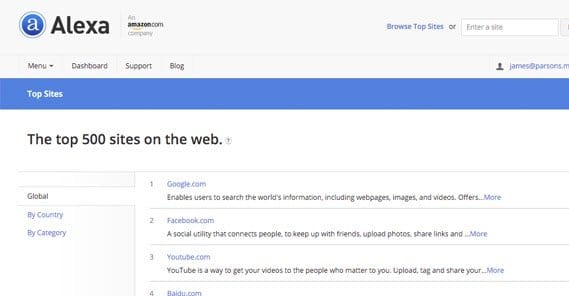What is Considered a High Ranking on Alexa.com?

Alexa is one of the oldest forms of non-Google rankings online with any sort of comprehensive scope. It’s very generalized, as it covers every industry, rather than just those basic top list sites that seemed to pop up everywhere a handful of years ago. You can’t pay to rank higher, you don’t get preferential treatment for ranking higher, and you’re not restricted to just ranking within your industry or within the scope of the site owner’s views.
No, Alexa is an “objective” ranking system, though I have to put objective in heavy quotes. Alexa has its flaws, and it has somewhat fallen out of style recently, but many people still use it or pay attention to it. Among other things, if you’re going to try to sell a site on Flippa or another site marketplace, you can bet that potential buyers all want to see your site’s Alexa ranking.
How Alexa Works
Alexa was an independent ranking company that was created to provide web data, founded in 1996. The company was purchased in 1999 by Amazon, and has been a wholly owned subsidiary ever since. It claims over 6.5 million visitors monthly, though a huge number of them are visiting for competitive analytics and other services, not for the website ranking list. At one point it had a web search of its own, though that was discontinued seven years ago. It has since focused entirely on analytics, tracking, and ranking via its own metrics.
Alexa ranks websites based on volume of traffic. That is, at the core of it, all. It is very different from Google, which has hundreds of ranking signals and a very complex algorithm tying it all together. Alexa just calculates unique visitors per day for a site, harvests that data over the course of several months, and keeps a rolling average. The average of the past three months is what determines the ranking of a site, so you can imagine there is quite a bit of fluctuation. Sites can go viral in three months, sites can die, seasonal sites can fluctuate, and it’s all very mobile. You ranking one day might not be the same as it is the next day.
Of course, there’s no way for Alexa – even backed by a company as huge as Amazon – to collect data on every web user at all times. That would be an incredibly massive flow of data, and would require insane collective resources to parse and track. If there are 3.2 billion internet users in the world, and the average web user visits 10 sites per day, that’s 32 billion website unique pageviews to track every day. If each pageview sends 1 kilobyte of data to Alexa, it has to parse 32 terabytes of data every day, which is 2.8 petabytes of data for their 3-month rolling calculation.
Now, those numbers are mostly just pulled out of thin air. I have no reliable source for the number of sites a user visits in a day, nor do I know what data Alexa harvests for a pageview and how big it is. Those two numbers can dramatically change the final numbers, upwards or downwards. Either way, it’s an insane amount of data.
No, Alexa doesn’t try to harvest everything. It harvests data from a small sample of Internet users. The problem comes from that sample; it comes from users who use the Alexa Toolbar. This toolbar is what allows Amazon to harvest the data it needs to measure traffic.
The Flaws With Alexa
There are problems with the way Alexa measures data, all stemming from that toolbar. For one thing, who uses the toolbar? Is it general web users? No, of course not; the toolbar doesn’t come pre-packaged on computers or embedded in browsers. The people who use the Alexa toolbar tend to be the people who care about Alexa ranking, or the readers of blogs who care and who have pushed the toolbar onto their readers.
That skews the audience Alexa measures dramatically in the direction of tech-oriented users who either know what they’re doing, or who don’t know enough to care about any side-effects a toolbar might have. That, of course, and web bots using the toolbar for people who sell Alexa hits.
It gets worse if you dig a little. In March of this year, a lot of people experienced a drop in Alexa ranking. Why? The reason is that Firefox issued a browser update and the Alexa toolbar did not support the new version of Firefox. That cut out a huge segment of users running the toolbar, so Alexa was only getting data from people using desktop Chrome with the plugin installed.
Wait, desktop Chrome? That’s right; Alexa isn’t supported on mobile browsers. That means the huge amounts of mobile traffic – which surpassed desktop traffic last year – isn’t recorded at all.
Despite all of this, people still care about Alexa ranking, so we might as well take a look. What is considered a high Alexa rank?
What’s a High Ranking?
This will largely depend on industry. Obviously, the #1 ranking would be the best of all but that spot is firmly taken up by Google. The #2 spot is Facebook, the #3 spot is YouTube, and the #4 spot is Baidu, the Chinese Google. #5 is Amazon, #6 is Yahoo, #7 is Wikipedia, #8 is QQ – China’s primary ISP portal – and #9 is Twitter. #10 is another Chinese site, Taobao, essentially the Chinese Amazon. It just goes on from there. You can see the top 500 list here.
Even that list can be inaccurate. The #500 spot is BHPhotoVideo.com, a high profile camera and video hardware shop, but when I click on the detailed overview, I see its rank as 616 globally, but 192 in the United States. Which ranking is more important? For BH, I’d say the US ranking, but who knows. It certainly doesn’t match ranking #500 with either of those numbers.
If you look specifically at the United States rankings, you see many of the same sites. The top ten are, in order, Google, Facebook, Amazon, YouTube, Yahoo, Ebay, Wikipedia, Twitter ,Reddit, and Go.com. If you’ve never heard of Go, don’t worry; it’s essentially a Disney news portal.
Comparing Industry Sites
To figure out what a good, high ranking for your site would be, what you need to do is do some industry research. For example, Growtraffic itself has a global rank of 39,798 as of this writing. That’s pretty good, all things considered; in the top 40,000 sites globally. Is that actually a high ranking or not, though? Well, what about other SEO/blogging/etc niche sites?
- Moz.com has a global ranking of 1,094, and it has dropped significantly. Back last December, they were in the top 500.
- Search Engine Land has a global rank of 1,451.
- Search Engine Journal is ranked 3,425.
- Neil Patel’s Quicksprout is 3,946.
- KissMetrics is ranked 5,842.
- Wishpond is ranked 7,238
- BoostBlogTraffic is 19,622.
So, in a highly competitive Internet Marketing niche, we’re perhaps not doing so hot. Then again, some other sites I checked were in the low 100,000s, or even lower. Some small blogs were under 300,000. It’s impossible to see their historical data for any site under 100,000, though, so I can’t tell you if they’re in a slump or growing.
For reference, those were all global ranks. What are the same sites ranked in the US?
- Growtraffic is 83,893.
- Moz is 3,559.
- Search Engine Land is 4,853.
- Search Engine Journal is 11,300.
- Quicksprout is 12,087.
- KissMetrics is 9,752.
- Wishpond is 8,869.
- BoostBlogTraffic is 21,257
So, you can see, the global ranking isn’t necessarily valuable if your audience is primarily in the United States. Almost all of these sites have much higher ranks in India than in the US, which makes sense given that India is one of the major global hubs of all things SEO, and many SEO professionals are of Indian descent.
Again, though, keep in mind that Alexa rank is no guarantee of success. Every one of these sites, including ourselves, shows up as result #1 for certain relevant queries. Some sites show up more than others, but it’s not reflective of the Alexa ranking.
Why Do People Care?
Why is Alexa Rank a ranking anyone looks at? With the data inconsistencies, why does anyone care? Why is it so big, even with Amazon support?
Well, for one thing, it’s about the only “true” traffic ranking. I put true in quotes because of all of the measurement issues. One site with 2,000 visitors will rank worse than another site with 1,000 visitors, if more of those 1,000 people use the Alexa bar. This is more true than ever with the March Firefox update and resulting loss of incoming data.
Alexa is a comparative tool. It’s not ranking you on an objective scale, it’s ranking you in comparison to other sites. Specifically, to every other site, including many, many sites that are not part of your niche. There are over 1,000 sites “better” than Moz, but how many of them are relevant to the Internet Marketing industry? I would wager very few.
Alexa is also used by people who matter, which is unfortunate. People who buy sites, and advertisers who want to value your site in their databases, tend to look at Alexa rank because their businesses also rely more on traffic than on other metrics. Even if the traffic numbers are unreliable, they can at least compare you to known performers and see where you stand.
Unfortunately, with the variability of low sample sizes and the fact that Alexa traffic can be purchased, it’s not a very reliable indicator. We could buy a bunch of Alexa traffic and skyrocket our ranking for a while, and indeed many people who sell their sites like to do just that for a few months prior to listing, to earn their site a higher valuation.
Alexa Ranking Alternatives
There are some other forms of ranking that use a lot better data sources that are both harder to manipulate and more comprehensive. For example, you have:
- Moz Rankings, like Page Authority and Domain Authority. These are probably the most comprehensive, accurate, and valuable metrics available to monitor on a broad scale.
- Majestic Rankings, which monitor trust and citation flow, sort of like PageRank but with more value analysis attached.
- Ahrefs Rankings, which monitor backlinks, URL rankings, and domain ratings.
PageRank, as we all know, is essentially a dead metric. You can still work to improve it if it ever does update, and those improvements will help with other metrics, so it’s not lost work.
So a lot of people figure that Alexa sucks, and an ever-decreasing number of people use it for web rankings, but that’s far from the only service they provide. In fact, Alexa is still a very valuable company with a lot to offer you. You just need to look at the other offerings they provide.
Alternative Benefits to Alexa
While traffic ranking is just a fickle and comparative metric, Alexa does also provide a lot of other data. They have different tiers of analytics access, from the $10/month basic to the $150/month premium plans. Basic includes on-site analytics and web research, the middle Insight tier has keyword research, deep metrics, and SEO auditing features, and the Advanced top tier has site audits, site discovery tools, monthly visitor metrics, and a lot more. You can learn about pageviews per user, bounce rates, time on site, search percentage, and a bunch of other tidbits.
The value here is all in having another perspective. There’s nothing really unique that Alexa provides about your own site that you can’t get from Google Analytics, Raven Tools, or any of the other suites out there. Think of it as fact checking or comparisons to gauge the accuracy of your analytics as a whole.
The place where Alexa shines with a paid account is competitive research. They are, frankly, one of the best remaining competitive keyword research tools. You can see where your competitors stack up for various keywords, and see what sort of keywords are sending traffic towards your competitors. This is pretty excellent all around, as it gives you a ton of opportunity to compete, as well as avenues to boost your content marketing.
Unfortunately, Alexa’s demographic information is very tertiary at best. It’s not all that great, because all it really shows is the basics. Geographic location by country, age, gender, education, it’s all very basic and it’s all data you should have from other sources in greater detail. The same goes for their Clickstream; a basic domain backlink analysis that you can get in greater detail and accuracy from Google Analytics.
All told, Alexa can be very valuable, but primarily in the inspiration and content planning arena. Competitive research is important to, well, compete, and that means having accurate data about your competitors is valuable. Just don’t use Alexa’s traffic ranking as if it matters; it really doesn’t.
 ContentPowered.com
ContentPowered.com









